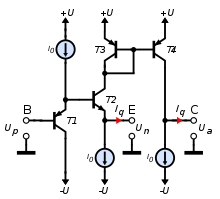Current amplifier
The current amplifier or CC operational amplifier , abbreviated to CC-OPV , is a special operational amplifier which, in contrast to the usual voltage-controlled operational amplifiers, has a current input and a current output. The circuit behaves like an ideal bipolar transistor and is used, among other things, as a broadband amplifier, bandwidths over 600 MHz are common, for the control of laser diodes for the supply of optical fibers and as a current driver for magnetic heads in magnetic recording systems.
General
Current amplifiers are usually operated in negative current feedback . Due to the similarity in the operating behavior to a bipolar transistor, the connections are designated as with a bipolar transistor with base (B), emitter (E) and collector (C) as shown in the adjacent circuit symbols. In addition to a high-resistance positive input (B), CC operational amplifiers have a low-resistance, negative input (E) with the input current I N and a current-controlled output (C) with the output current I a . The two currents are related to the current transfer factor k :
The current transfer factor k depends on the type and is in the range from 1 to 10.
Circuit description
As shown in the simplified circuit diagram with a current transfer factor of 1, a CC-OPV consists internally of the input stage, formed by the emitter- connected transistor T2 whose offset voltage is compensated by T1 . The current mirror and output stage are formed by the two transistors T3 and T4 . The output current adjusts itself to the same amount as the input current I q .
The current amplifier is usually operated as a current driver with negative current feedback in an emitter circuit in order to limit the slope of the amplifier. The negative feedback occurs through an additional external resistor at connection E to ground. Since it is a current output, there must be a load at output C during operation, for example in the form of a laser diode .
The CC operational amplifier can be used to form the basic circuits known from voltage-controlled operational amplifiers, such as subtractors or integrators . For example, an integrator is formed by a capacitor as a load at output C.
Comparison with bipolar transistor
What they have in common with the bipolar transistor is the fact that the output current (collector current) at k = 1 is the same as the input current (emitter current) and the output resistance at the collector is high. Furthermore, the input resistance at the positive input B (base) is high, while the input resistance at the negative input E (emitter) is low.
There are also deviations from conventional bipolar transistors, which describe the CC operational amplifier as an "ideal" transistor. The English brand name Diamond Transistor, introduced by the semiconductor manufacturer Burr-Brown , follows from this fact .
The main differences of the ideal behavior are the base-emitter voltage at the operational amplifier CC, this is equal to the differential input voltage U d between the two inputs of which 0 V is. The emitter and collector currents can flow in both directions, expressed by the double arrow in the circuit symbol, which means that there is no distinction as with bipolar transistors in the form of npn and pnp types.
literature
- Ulrich Tietze, Christoph Schenk: Semiconductor circuit technology . 12th edition. Springer, 2002, ISBN 3-540-42849-6 .
Individual evidence
- ↑ Klaus Lehmann: Application bulletin: Diamond transistor OPA660. Burr-Brown, accessed August 24, 2016 .


